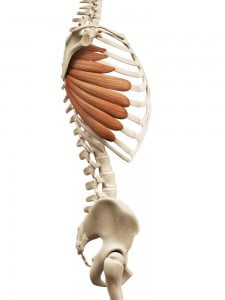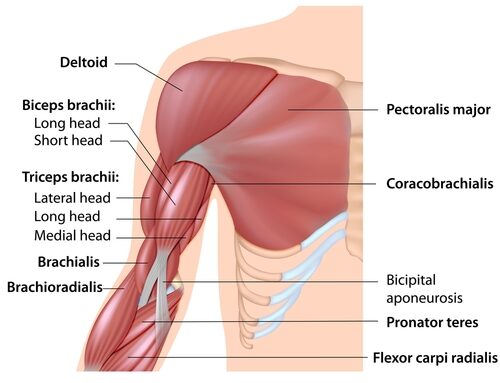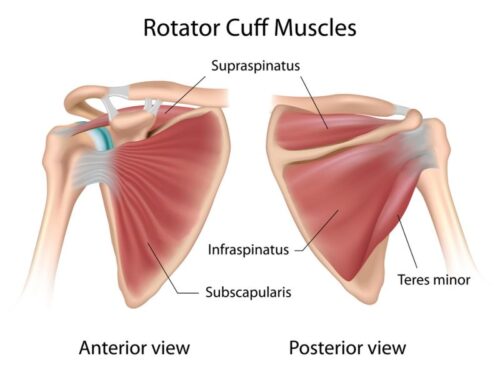Serratus Anterior Muscle Pain

Does it hurt to breathe? Did it start after a really long run or after you were sick?Have you ever experienced a sharp, burning sensation in your shoulder blade or chest? You may be experiencing pain in your serratus anterior muscle. This muscle is located on the sides of your rib cage and is an important part of your core strength. In this article, you’ll learn more about the serratus anterior muscle and what can cause it to become painful.
The serratus anterior is vital for activities such as reaching overhead, pushing and pulling. When this muscle becomes weak or tight, it can cause pain and difficulty with everyday tasks.
In this article, I’ll explore the anatomy of the serratus anterior muscle, its common causes of pain, and some treatments that can help relieve discomfort. If you’re looking for answers about how to manage your pain, then keep reading!
The Location And Attachment Points
The serratus anterior muscle is a thin and superficial muscle that originates from the side of the first 9 ribs and attaches to the shoulder blade, helping to move it in various directions. It is key for upward rotation of the shoulder blades, which allows for better range of motion in the arms. Because the serratus anterior attaches to the scapula, when it is tight it can cause a winged scapula.
Pain Patterns
Pain patterns in the serratus anterior muscle can be quite confusing. It’s hard to identify exactly where the pain is coming from and how it’s connected to our shoulder pain.
If trigger points are troubling the serratus anterior, you might experience pain at the side of the ribcage and at the lower and medial border of the scapula.
Pain can refer down the whole inner side of the arm as well. Also, the inner hand and 4th and 5th finger might be painful. It can also cause abnormal breast sensitivity. [How to differentiate between bicep pain]
The serratus mainly contributes to…
- Pain between shoulder blades
- Golfers elbow pain
- Rib pain
- Arm pain
Serratus anterior pain will be most evident when taking deep breaths as it supports breathing. This is the muscle that causes “side stitches”. It can make your ribs feel stuck.
Function Of The Muscle
This muscle stabilizes the scapula, but it also works in rotating and abducting the arm. It also plays a role in deep breathing, so if you’re experiencing chest pain around your rib cage, it could be related to this muscle.
Trigger Point Activation
A bad cough and sprinting are the two most common causes of creating trigger points in the serratus anterior. The vigorous forward and back motion with the arms causes the serratus to work overtime.
Associated Conditions
This muscle attaches to the ribs and shoulder blade, so it can be easily strained if you overwork your shoulder or arm. A rotator cuff tear is one condition that can cause pain in this area. A symptom of a tear is scapular winging when the shoulder blade protrudes outwards due to weakened muscles.
A serratus anterior injury can be caused by damage to the long thoracic nerve, which is located near your armpit. This type of injury may occur when undergoing surgeries that involve your shoulder or lymph node resection for breast cancer patients. Strenuous physical activity can also cause the nerve to become overly stretched.
If your rib cage sustains an injury, the serratus anterior–which attaches to it–may suffer damage as well. In certain cases, a fracture in the ribs can cause the tissue of this muscle to be pulled away and broken off, resulting in what is known as an avulsion fracture. This type of breakage is not only painful but also decreases the mobility of the shoulder girdle.
Occasionally, people can experience weakened serratus anterior and scapular winging without any obvious explanation. Parsonage-Turner Syndrome is a condition that could be the cause of such an issue as it affects your brachial plexus and long thoracic nerve, leading to Brachial neuritis which consequently weakens your serratus muscles and causes the distinctive scapula winging symptom.
Rehabilitation Of The Muscle
Working with a physical therapist or massage therapist can help you recover after an injury to your serratus.
Some of the treatments for a serratus anterior problem can include:
- Massage Therapy
- Exercises
- Dry Needling
- Cupping
- Electrical Stimulation
 A physical therapist will help you identify the underlying cause of your muscle pain and develop a plan for rehabilitation. This may involve stretching exercises, strengthening exercises or both. You’ll also need to pay close attention to your posture and be mindful of how you’re using your body throughout the day, as poor posture can contribute to weakened muscles in this area.
A physical therapist will help you identify the underlying cause of your muscle pain and develop a plan for rehabilitation. This may involve stretching exercises, strengthening exercises or both. You’ll also need to pay close attention to your posture and be mindful of how you’re using your body throughout the day, as poor posture can contribute to weakened muscles in this area.
Do whatever you can to NOT cough. Clear your throat instead and drink lots of water. I find that apple cider vinegar helps a lot when I have a cough. I just take a swig in the morning.
You will also want to avoid pushups, overhead presses, and any sort of pull-ups until the trigger point goes away.
If it bothers you when you sleep, hug a pillow with the bad side on top. [How to Relieve Shoulder Blade Pain]
Frequently Asked Questions
What Does Serratus Anterior Pain Feel Like
When you experience serratus anterior pain, it can be difficult to describe. It’s often a sharp and stabbing sensation around the medial aspect of the shoulder blade and chest area. Some people feel as if their ribs are being pulled or stretched, while others feel a burning ache in the affected area. The serratus anterior is sometimes referred to as the boxer’s muscle because of its role in punching motions, so some may experience pain that feels like an intense bruise on the chest wall.
It’s important to remember that pain in the serratus posterior can also be mistaken for serratus anterior pain. This means diagnosing and treating your condition correctly is essential for successful rehabilitation of the muscle. To help determine if it is indeed your serratus anterior causing discomfort, pay attention to where you feel pain when you move your shoulder blade, arm, or ribcage.
No matter how it feels, addressing any kind of chronic chest or shoulder blade pain should not be taken lightly and seeking medical advice is recommended if symptoms persist over time. Your physician will likely take a look at your medical history and perform physical examinations to diagnose what’s causing your discomfort and develop an effective treatment plan tailored specifically for you.
What Causes Serratus Anterior Pain
Serratus anterior pain may be caused from excessive running, push-ups, lifting weight overhead, swimming or severe coughing. This muscle is especially sensitive to fast, unexpected movements like having to make a quick turn on the steering wheel to avoid an accident.
coughing. This muscle is especially sensitive to fast, unexpected movements like having to make a quick turn on the steering wheel to avoid an accident.
How Can I Prevent Serratus Anterior Pain?
Preventing serratus anterior pain is something we all want to do. It’s important to be proactive in maintaining your physical health, so you can continue doing the things you love without experiencing discomfort. I’m here to share some tips to prevent this type of muscle pain from occurring.
First, strengthen your core muscles. Your core muscles provide the necessary balance and stability for all physical activities. Doing simple exercises like planks and crunches can help build strength in your core and make it easier for the rest of your body to remain balanced when working out or engaging in other physical activities. Obviously, you want to prevent serratus anterior weakness as well. You can perform wall slides or these 3 exercises to keep the serratus strong.
Second, use proper form when exercising. It’s important to pay attention to how you’re moving while carrying out any kind of exercise routine; the incorrect form can lead to injuries and muscular imbalances that could cause pain in the long run. Make sure you’re using proper posture throughout every move; if you have difficulty understanding the correct form, don’t hesitate to consult a professional trainer for help!
Finally, give yourself time off between workouts or strenuous activities. Overworking any muscle group can lead to painful inflammation, so be sure to give yourself enough time between these activities – even if it just means taking an extra day or two off a week – in order for your body to recover properly and avoid potential injury.
One more tip, avoid long bouts of heavy coughing. If you have a persistent cough, try clearing your throat instead or go to the doctor for a cough suppressant.
Is Serratus Anterior Pain Serious?
Serratus anterior pain is usually caused by a muscular imbalance between your pectoral muscles and your back muscles. It can cause sharp pain on one side of your body around the ribs or shoulder blade area. The intensity of the pain can range from mild to severe and in some cases, serratus anterior pain may radiate down the arm or up into the back. [Read here if it’s your mid back that hurts]
If you’re experiencing serratus anterior muscle pain, it’s important to seek medical advice to determine whether any underlying conditions may be causing it. In many cases, simple exercises with a physical therapist or a massage with a licensed massage therapist can help reduce the intensity of the symptoms and reduce your risk of further injury. However, if left untreated, this type of muscle pain can worsen and become quite painful over time. So don’t wait too long to get help if you think you’re experiencing serratus anterior muscle pain. Taking action now could save you from a lot of discomfort in the future.
What Are The Most Effective Treatments For Serratus Anterior Pain?
When it comes to treating pain in the serratus anterior muscle, the most effective solutions are those that address the root cause. This can be tricky, as pain in this area can arise from a variety of sources. Fortunately, there are a range of treatments available that can help reduce or even eliminate this type of pain. Here’s what you need to know:
First, identify the cause of your pain. Serratus anterior muscle pain may be caused by an injury, such as a strain or tear, or it may be due to postural problems. In some cases, it could also be linked to underlying health issues such as arthritis or bursitis. Once you have identified the source of your discomfort, you can determine which treatment option is best for you.
Here are five popular treatments for serratus anterior pain:
• Resting and icing: Taking time off from activities that aggravate your pain can help reduce inflammation and improve healing time. Applying ice or cold packs to the affected area can also provide relief.
• Physical therapy: A physical therapist can teach you exercises and stretches that help strengthen the muscles around your serratus anterior and prevent further injury in the future.
Massage Therapy: A massage therapist can perform soft tissue manipulation and trigger point therapy to help reduce myofascial pain and relieve muscular tension.
• Pain medication: Over-the-counter anti-inflammatory medications such as ibuprofen may help relieve swelling and discomfort. Your doctor may also prescribe stronger medications if needed.
• Surgery: In some cases, surgery may be necessary to repair any damage to the muscle or surrounding structures. Your doctor will discuss all your options with you before deciding on a course of action.
It is important to talk to your doctor about any persistent pain in your serratus anterior muscle so they can diagnose the cause and recommend appropriate treatment options for you. With proper care and attention, you should be able to get back on track toward feeling better soon!
When Should I Seek Medical Attention For Serratus Anterior Pain?
If your serratus anterior pain is accompanied by other symptoms like numbness, tingling, or loss of strength in the affected area, then you should definitely seek medical advice. In addition, if your pain persists despite at-home treatment such as rest and stretching exercises, then you should also consult a doctor.
It’s also important to pay attention to how long your discomfort has been going on. If it’s been present for more than three weeks and isn’t getting better with home treatments, then you should see a medical professional as soon as possible. That way, they can identify the underlying cause of your pain and develop an effective treatment plan for you.
No one likes dealing with persistent muscle pain – but ignoring it won’t help either. So if your serratus anterior pain is ongoing or worsening over time, don’t wait any longer – make sure to get help from a healthcare provider today!
Conclusion
The serratus anterior muscle is an important muscle for daily activities, and pain in this area can be quite disruptive. Fortunately, there are several strategies that you can use to prevent and manage this type of pain. It is important to practice proper body mechanics during activities, as well as regular stretching and strengthening of the muscles in the area. In addition, if you experience persistent or severe pain, it is best to seek medical attention so that an accurate diagnosis can be made and appropriate treatment is prescribed.
By taking proactive steps such as practicing proper body mechanics and actively engaging in physiotherapy exercises, you can decrease your risk of developing pain. Additionally, if you experience any signs of serious injury or notice a worsening of symptoms over time, it is important to seek medical help promptly. With appropriate preventive measures and treatments, you should be able to enjoy a healthy lifestyle without worrying about chronic serratus anterior muscle pain.
We would love to be your first stop when dealing with your serratus anterior pain. Please give us a call to schedule a massage or you can schedule right online!







